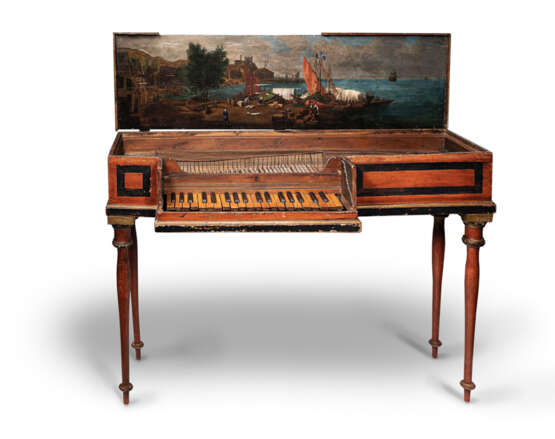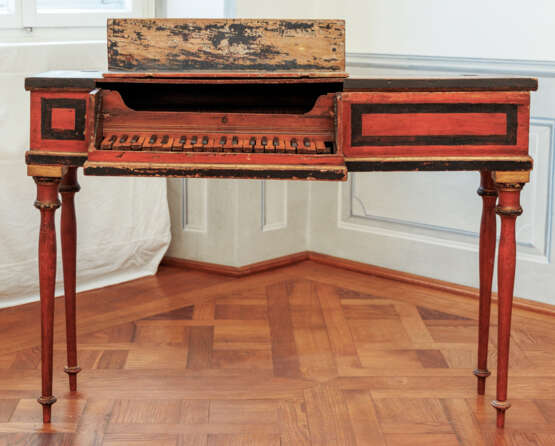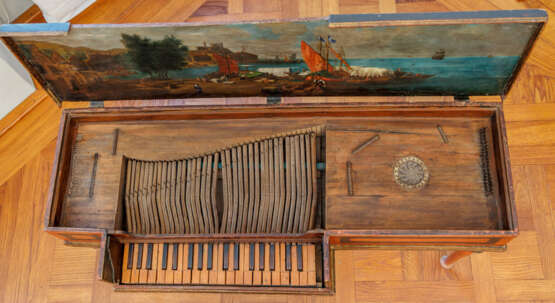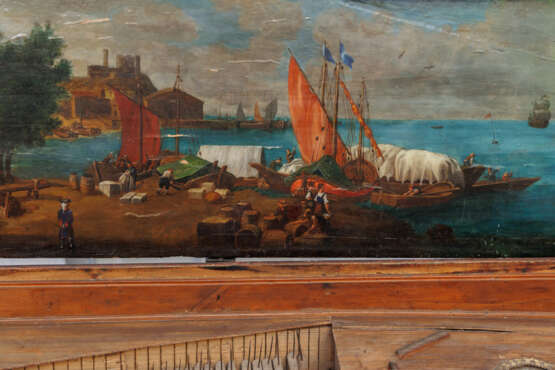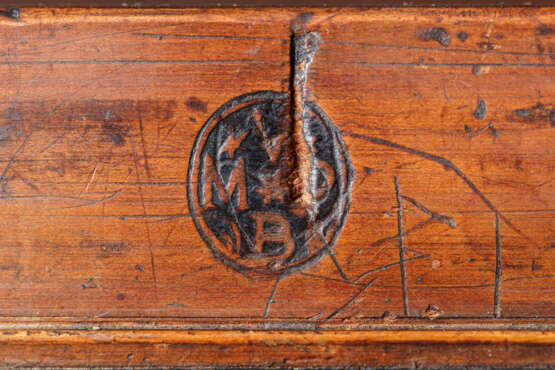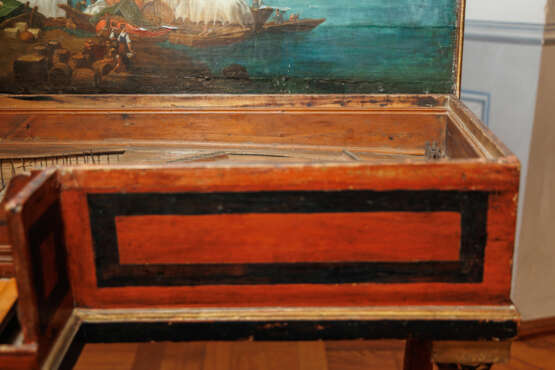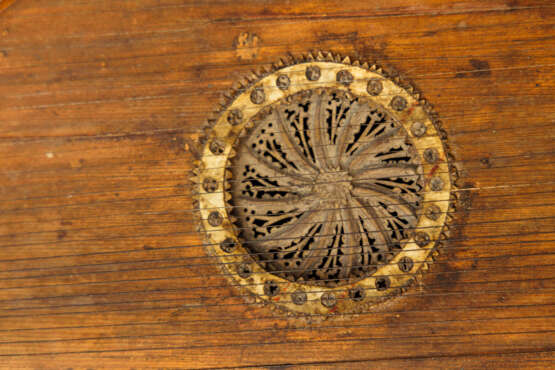ID 909784
Lot 37 | HISTORISCHES ITALIENISCHES CLAVICHORD, UNSIGNIERT
Estimate value
€ 2 000 – 4 000
Dieses Clavichord ist außen mit schwarzen Kassetten auf rotem Grund bemalt. Die Innenseite des Hauptdeckels zeigt eine gemalte Hafenszene mit Figuren, Gebäuden, Bäumen und Schiffen. Das Instrument ist nicht spielbar.
Die Klaviatur (F-f2) besitzt eine Hintertastenführung (Kanzellenführung). Sie weist Wurmfraß auf. Das Vorsatzbrett trägt einen Stempel (möglicherweise eingebrannt) mit den Buchstaben „M*D*V*B“, in einem Kreis angeordnet.
Das Instrument weist 20 Saitenchöre auf.. Die Zargenwand des Gehäuses ist durch den Saitenzug leicht oval verformt. Ein Dammloch existiert nicht. Zu beiden Seiten befinden sich Resonanzböden. Der rechte Resonanzboden ist mit einer gestuften Pergament-Rosette versehen. Der Resonanzboden ist zum Stimmstock hin abfallend.
Das Instrument weist Charakteristika der frühen Clavichorde aus dem 16. Jh. auf:
Verschiebbare, geteilten Stege;
Ungewöhnlich hohe Zarge;
Zum Stimmstock hin abfallender Resonanzboden;
Hervorstehende Klaviatur
Abmessungen des Instruments:
Länge: 1209mm
Breite: 355/471mm
Gesamthöhe: 849mm
Korpushöhe: 190mm
Das Instrument wurde im Jahr 1986 bei Sotheby’s in London erworben.
Frühe Clavichorde finden sich in den bedeutendsten Sammlungen der Welt:
Deutschland, Leipzig, Grassi-Museum: Clavichord von Pisaurensis, Inv.-Nr. 1
Deutschland, Leipzig, Grassi-Museum: Clavichord anonym, Ex-Kraus, Inv.-Nr. 2
Deutschland, Leipzig, Grassi-Museum: Clavichord anonym, Ex-Kraus, Inv.-Nr. 3
USA, Boston, Museum of Fine Arts: Clavichord anonym, Inv.-Nr. 17.1796
Belgien, Brüssel, Museum der Kunstgeschichte: Clavichord, zugeschr. Giovanni Celestini, Inv.-Nr. 1620
USA, New York, MET-Museum: Clavichord von Alessandro Trasuntino, Inv.-Nr. 2543
HISTORICAL ITALIAN CLAVICHORD, UNSIGNED
On the outside, this clavichord is painted with black cassettes on a red background. The inside of the main lid shows a painted harbour scene with figures, buildings, trees and ships. The instrument is not playable.
The keyboard (F-f2) has back guided keys (Kanzellenführung). The keyboard shows a worm damage. The front board bears a stamp (possibly burned in) with the letters "M*D*V*B", arranged in a circle.
The instrument comes with 20 pairs of strings. The case has been slightly deformed oval by the tension of the strings. There is no hole in the bellyrail. There are soundboards on both sides. The right soundboard has a multi-layer rosette, made from parchment. The soundboard slopes down towards the wrestplank.
The instrument shows characteristics of the early clavichords from the 16th century:
Sliding, divided bridges
Unusually high case
Soundboard slopes down towards the wrestplank
Protruding keyboard
Dimensions of the instrument:
Length: 1209mm
Width: 355/471mm
Total height: 849mm
Body height: 190mm
The instrument was purchased at Sotheby's in London in 1986.
Early clavichords are displayed in the most important collections of the world:
Germany, Leipzig, Grassi-Museum: Clavichord von Pisaurensis, Inv. no. 1
Germany, Leipzig, Grassi-Museum: Clavichord anonym, Ex-Kraus, Inv. no. 2
Germany, Leipzig, Grassi-Museum: Clavichord anonym, Ex-Kraus, Inv. no. 3
USA, Boston, Museum of Fine Arts: Clavichord anonym, Inv. no. 17.1796
Belgium, Brussels, Art & History Museum: Clavichord, assigned Giovanni Celestini, Inv. no. 1620
USA, New York, MET Museum: Clavichord von Alessandro Trasuntino, Inv. no. 2543
| Auction house category: | Musical instruments and accessories |
|---|
| Auction house category: | Musical instruments and accessories |
|---|
| Address of auction |
Galerie Moenius AG Kirchstraße 1 56653 Wassenach Germany | |
|---|---|---|
| Preview |
| |
| Phone | +4915782646146 | |
| Conditions of purchase | Conditions of purchase | |
| Shipping |
Postal service Courier service pickup by yourself | |
| Payment methods |
Wire Transfer |
